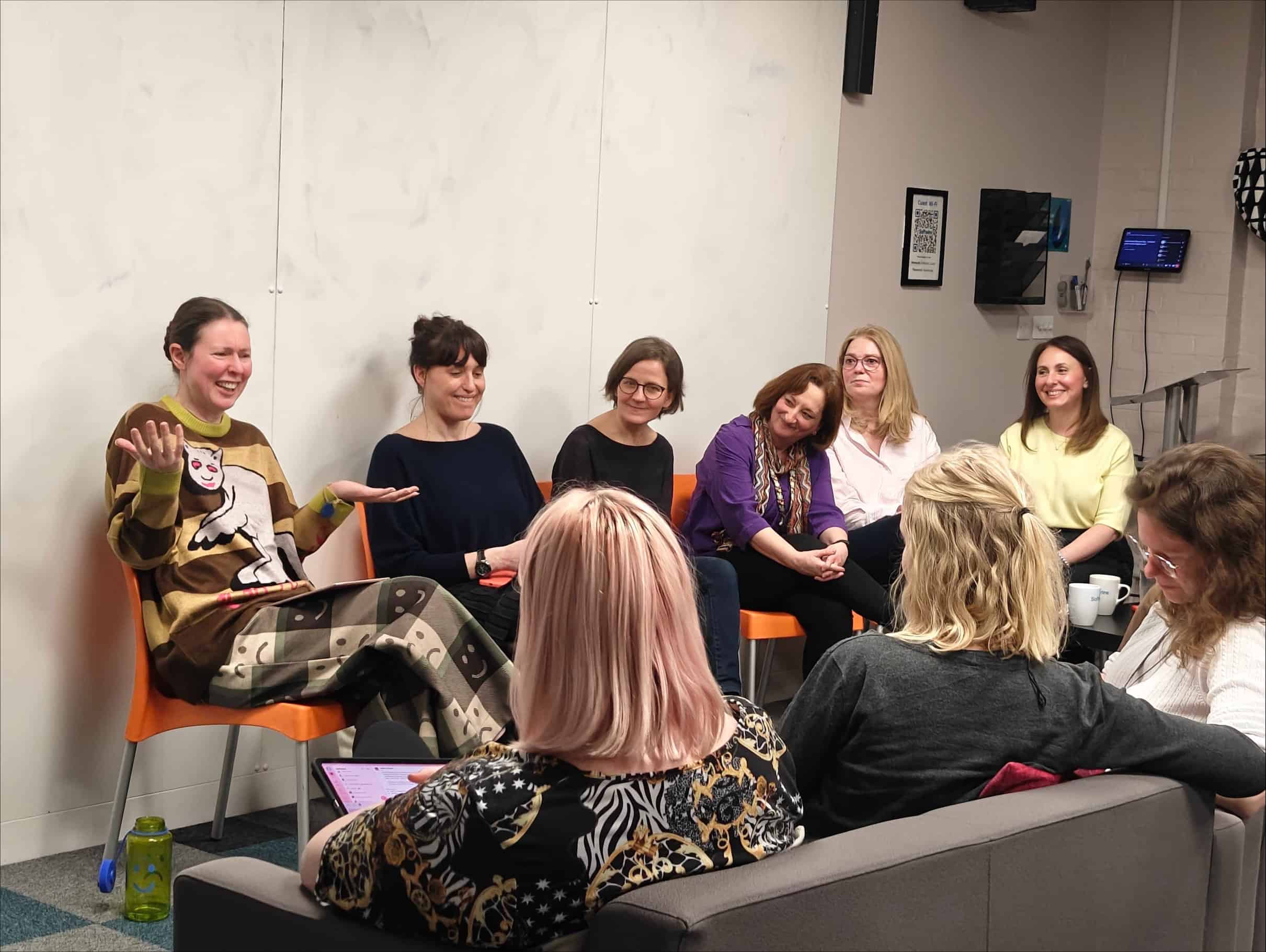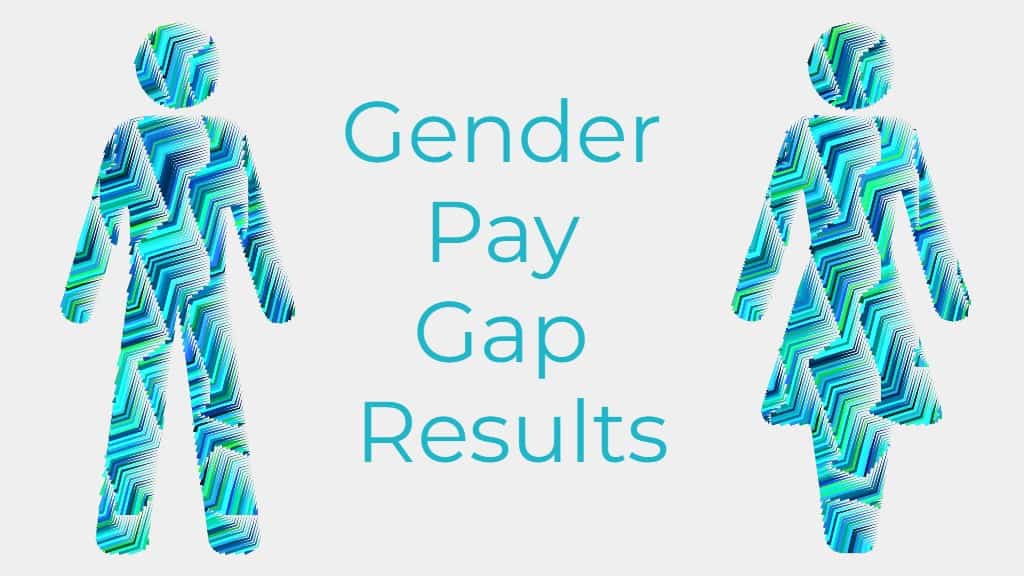
Over the past few years, Softwire has been thinking a lot about Diversity, Equality and Inclusion, because we want a workplace culture that supports, accepts and encourages a rich range of talents, opinions and backgrounds. We know that this translates directly to happier colleagues, better work/life balance and increased productivity. In addition, research has shown that diverse teams are more innovative and stronger at anticipating shifts in consumer needs.
Our values represent our public commitment to getting the best outcomes for our employees and clients, and we’re proud of our achievements in this area – for instance, this year, Softwire was one of the UK’s top large companies for Wellbeing.
But we’re always looking for opportunities to do more. Most recently, our annual Gender Pay Gap reporting provided the chance to review our progress against some relevant key objectives:
- Opportunity: Attract, hire and retain people from a wide range of different backgrounds
- Fairness: Pay everyone fairly and provide equal opportunity to progress
- Representation: Build a more diverse and representative leadership team
Below, we’ll analyse Softwire’s 2021/2022 gender pay gap report results and use them to explore each objective, sharing what we’re doing for each, how we’re performing against them and what we’d like to achieve in the future.
(Note: We’ll be focusing on gender equality performance in this article, but we recognise that there are other types of equality – race, class, neurodiversity and disability, for starters – which will also be given appropriate and careful attention in future articles.)
Softwire’s Mean and Median Gender Pay Gap
Our annual gender pay gap calculations are based on employer payroll data and the information we gathered revealed some useful insights.
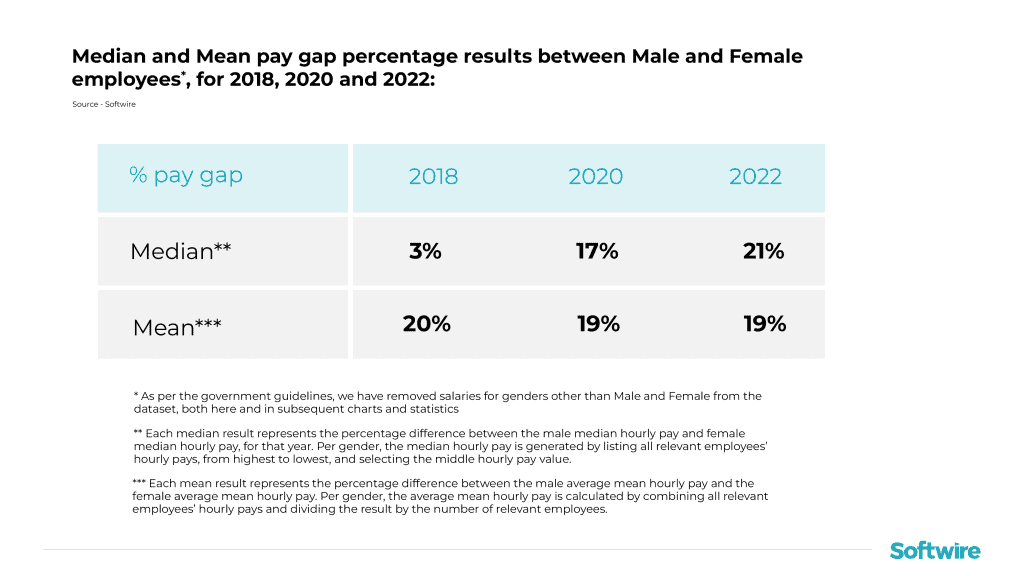
As you can see, there’s a significant upwards trend in our median pay gap results. Does that imply that we are performing worse against our objectives of opportunity, fairness and/or representation? Upon closer inspection, the answer is a clear no. In fact, the main driver behind the increase is the significant improvement in access that we’ve achieved in the past few years.
There are two large forces acting on our median pay gap results:
- Pay rises for existing employees (which pulls the median pay up) and
- Hiring new employees (which generally pulls it down, as we mostly hire into junior positions).
These forces can be better viewed if we breakdown our employee hiring by gender: In 2018, we started with 93 male employees and 26 female employees, and since then, we’ve hired an additional 102 male employees and 105 female employees (downward force). Overlaid with this, is the upward force of the global pay rises given to all 2018 employees (119 in total):
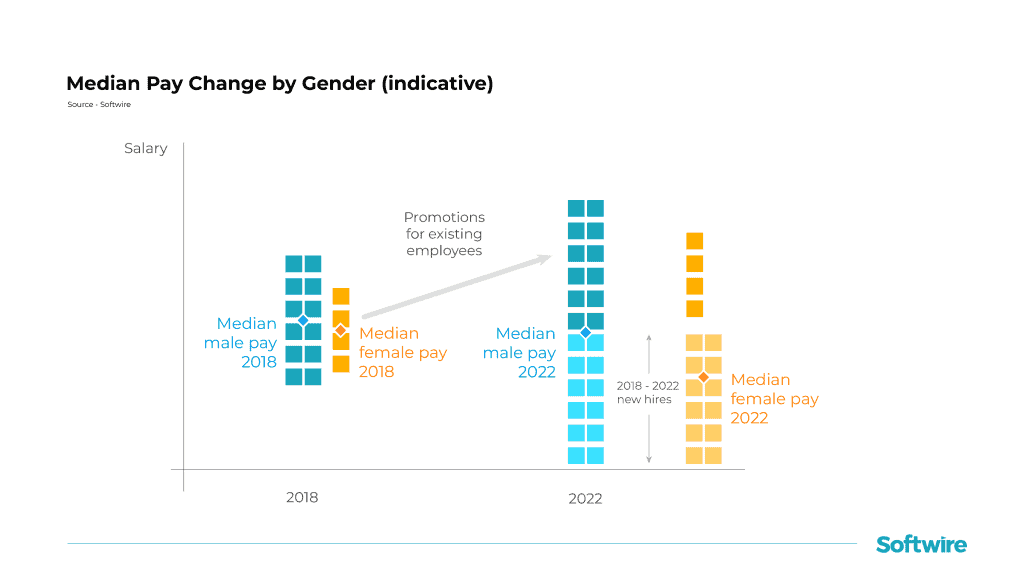
While the number of new hires is similar across each gender, the greater number of existing male employees does a better job of balancing that downwards force out, which has the effect of widening the median pay gap.
The good news: If Softwire maintains gender parity in our hiring, promotion and retention rates, our median pay gap will start to narrow again – as of next year, it will begin to drop, falling to below 5% within the next 5-10 years. (Note: The Mean pay percentage gap is a lot harder to predict, as it can be significantly affected by changes to a small number of remuneration packages.)
Three approaches to making our gender equality results clearer
Given the limitations of the headline metrics, we need to review additional metrics covering our three objectives: Opportunity, Fairness and Representation.
1. Opportunity: Attract, hire and retain people from a wide range of different backgrounds
Our assessment: Big improvement in the past 5 years
Looking back at the Softwire of 5-10 years ago, we were a smaller and more homogenous organisation, made up mostly of white, male software developers from a small number of universities. We identified this as a key issue for the long-term health of our business – There was a high risk of it impacting our ability to make the best strategic decisions, design software that meets clients’ needs, and attract and retain the best and most promising talent.
As a result, we embarked on a project to identify and recruit talented people from a significantly more diverse pool – in terms of race, gender, educational background, and role. Our strategy included:
- Creating a software development apprenticeship programme,
- Launching our own coding bootcamp, Techswitch,
- Offering a dedicated recruitment stream for career switchers & returners,
- Running outreach programmes for people from under-represented backgrounds,
- Making Softwire a more attractive proposition through offerings such as flexible working, and
- Focusing on inclusivity and reducing bias in our selection process.
The improvements have been successful and driven positive change: Over the last three years, over 50% of our permanent hires were female, and over 30% were from under-represented ethnicities.
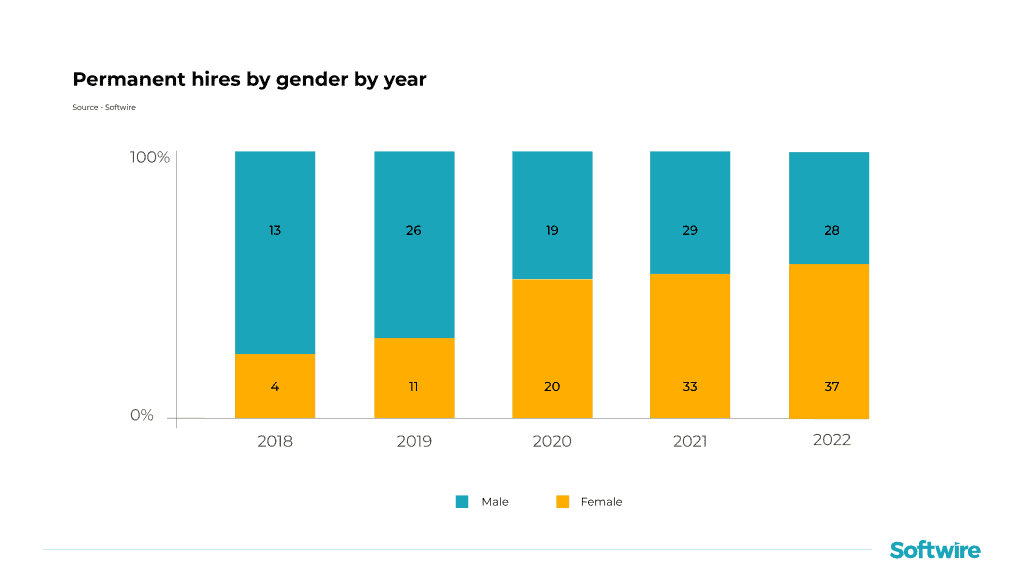
Retention by gender
It’s also important that we retain our employees once we’ve hired them. Of the 110 people who were working here on 1st January 2017, 57% of them are still at Softwire, which is fantastic. However, when we breakdown that by gender, we see a gap – we have a 61% retention rate for men in that group, but only a 44% retention rate for women.
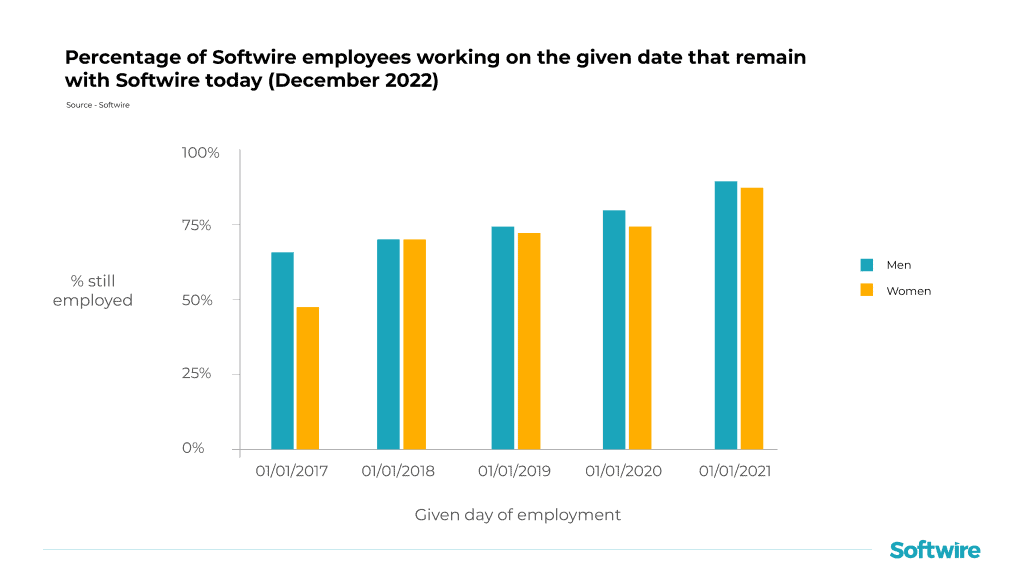
We’ve been addressing the underlying causes behind this gap, which has led to closer aligned results between genders.
To reach our goal of equality here, we continue our commitment to creating a fully inclusive environment, ensuring equality of career progression opportunities and offering flexible working options.
2) Fairness: Pay everyone fairly and provide equal opportunity to progress
Our assessment: A strength, especially for technical roles
The guiding principle in Softwire’s remuneration system is to ensure that everyone is paid fairly based on their contribution. In other words, people doing similar roles contributing at the same level should be paid the same.
We have a successful track record of abiding by this principle: we’ve had transparent salaries and a consistent pay structure for many years, and we’ve scored well when polling employees on their satisfaction with the process.
There’s always room for improvement, and we’re halfway through an 18-month process of trying to make our promotions process fairer, easier to engage with, and more transparent – with a particular focus on roles that are newer to the company (including many non-technical roles).
We use several metrics to measure fairness and equality of opportunity, one of which is derived from our gender pay gap data: ‘Median gender percentage pay gap, broken down by length of service and role type’.
Here’s the results for the delivery team that comprises 75% of all employees:
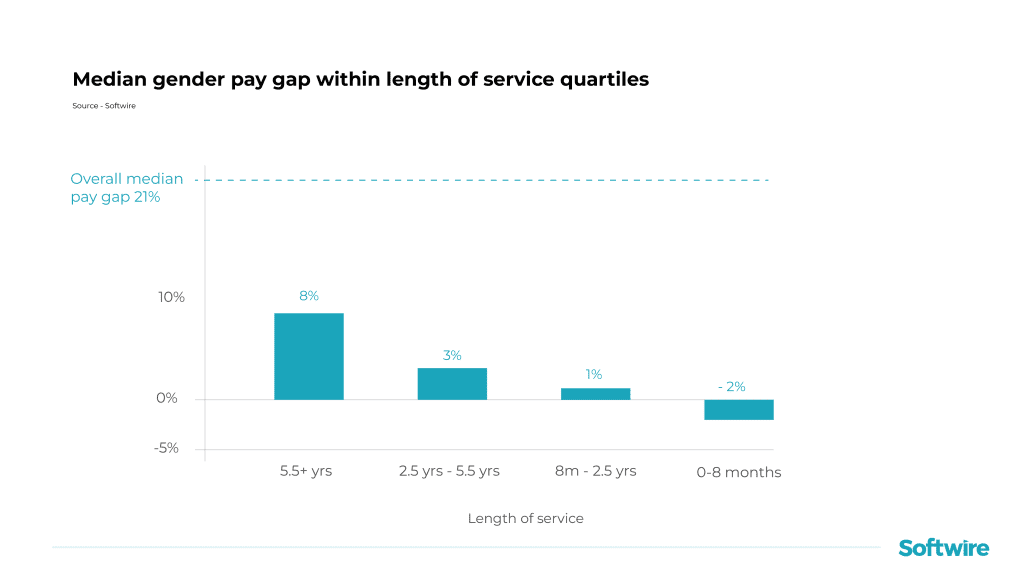
The median gender pay gap percentages are far lower here than our median headline figures – indeed, among the most recently hired quartile (0-8 months), women are paid slightly more than men.
In the future, we would like to see the median gender pay gap percentage in the longest-serving quartile (5.5 years +) come down, even though we know that this figure is vulnerable to large fluctuations if the number of employees sampled is small. We are confident that we can influence the longer-term trend by making inclusivity a key objective of our leadership development programme and our promotion review processes.
3) Representation: Build a more diverse and representative leadership team
Our assessment: Moving in the right direction
A couple of years ago, representation at leadership levels was one of our most glaring problems. Due to our high retention rate and focus on internal promotion, almost all our leaders had been at Softwire for over 10 years. This meant that our leadership team looked more representative of the Softwire 10 years prior and didn’t reflect the changes to entry-level hiring we’d already been making.
However, in the last two years, we’ve made a significant difference to the makeup of our exec team and senior roles. This is in part through hiring a lot more experienced staff. As we’re doing this at scale for the first time, we are making sure to include diversity, equity and inclusion into experienced hiring processes from the get-go. We’ve made a decent start: our senior hires this year were 50% female.
We’re also careful not to impact any promotion opportunities for existing staff, so that our efforts increasing entry-level diversity and equality of opportunity aren’t diluted. We’re already starting to see a more diverse pool of junior leaders rising through the ranks, and we expect to see that impact reach our senior leadership over the next 5 years.
One useful metric for tracking our progress towards this goal is the representation of women at different levels at Softwire (Whole company; Top 75% earners, Top 50% earners and Top 25% earners):
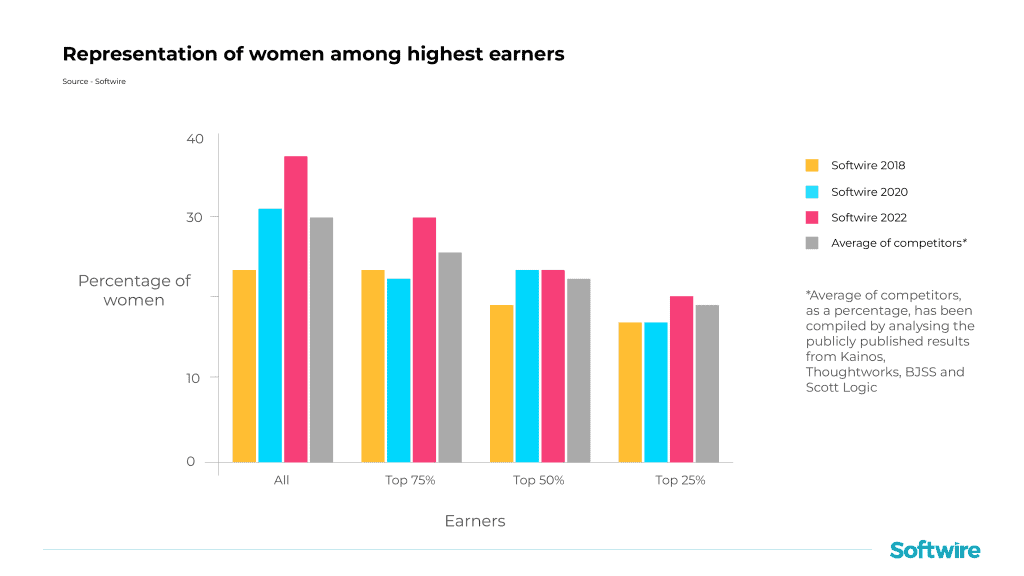
This illustrates a few things:
- Looking at the company as a whole, the percentage of female employees is increasing at a steep rate, reflecting our commitment to equal opportunity hiring.
- Looking at the breakdown by salary, our gender balance is improving most rapidly at junior levels, as we expected. , In top earning positions, it’s also starting to shift.
- This year, it’s really great to see that female representation is doing better in every quartile, when compared to the average results from other technology employers.
Within the next 5-7 years, we would like 40% of our top 50% of earners to be women – up from the 22% it is now. And moving forwards, our goal continues to be building a leadership team that reflects the diverse backgrounds of our employees and the users and clients we work for.
We’re on track to continue improving gender diversity across our pay, hiring and senior representation. We welcome your feedback and would be happy to discuss our results further, so please get in touch if you’d like to speak to me or my team.
If you’d interesting in changing to, or re-entering a career in software development, take a look at Techswitch for more information on taking part in its free bootcamp.

